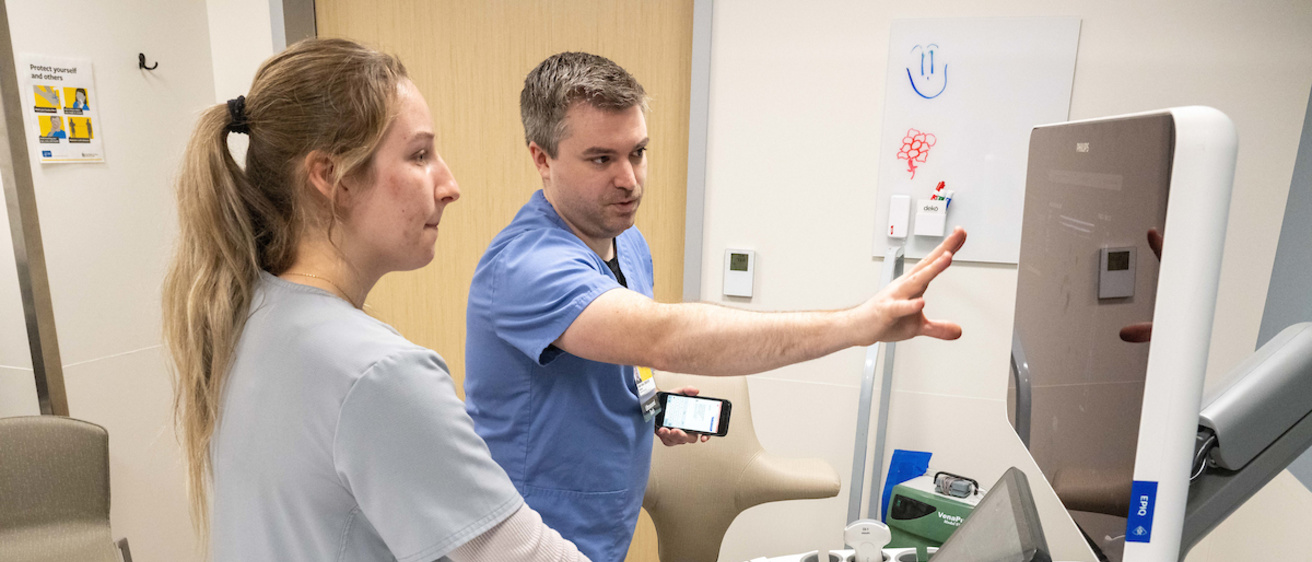
Breadcrumb
Building a reputation in big data
Since 2022, the College of Public Health’s Clinical Trials Statistical and Data Management Center (CTSDMC) has shifted its technical systems and support to ITS Enterprise Infrastructure. The move has strengthened the CTSDMC’s capacity to support multicenter research studies like the Parkinson’s Progression Markers Initiative (PPMI) sponsored by the Michael J. Fox Foundation.
Over the same period, the Iowa Health Data Resource (IHDR) has built its cadre of faculty and staff “data liaisons” and expanded research use of datasets drawn from tens of thousands of clinic records.
Supporting clinical research
The CTSDMC has provided data management services for investigators at Iowa and 100-plus institutions worldwide since 1989. As its portfolio and profile have grown, so have its technology needs.
“We’re an academic contract research organization, one of very few based at an academic center,” says Dixie Ecklund, director of operations for the center. “We make promises and take payments, which means prioritizing functions like disaster recovery, failover, and 24/7 support.”
In 2022, the Michael J. Fox Foundation approached the CTSDMC about providing the data management core for the PPMI, a long-running project to chart progression of Parkinson’s disease.
The CTSDMC already provided the statistical core for the study, but taking over data management posed a new set of challenges.
“This is a 12-year-old observational study with 50-some research sites in North America, Europe, the Middle East, and other locations,” Ecklund says. “Its data management rules hadn’t been very strict, so we needed to clean the database, ensure its availability to all participating sites, and integrate with other systems.”
For help, they turned to ITS’s Enterprise Infrastructure group. Together, the teams established SQL server database hosting for PPMI, as well as enhanced monitoring, security, disaster coverage, and other services.
Their support has enabled findings like a new test for Parkinson’s that can detect and classify the disease before movement symptoms arise.
“Technology is what we do, but teaching, research, and public service are what we support,” says Andrea Mascher, lead for Enterprise Infrastructure’s SQL Server DBA team. “It’s exciting to see the tech we work with every day help make a difference for people in our community and beyond.”
But PPMI was just the start. CTSDMC proceeded to transfer its entire platform to ITS, setting up eight SQL Server instances and nearly 500 databases. The move promises fast, reliable support and opens avenues to other ITS teams working on issues like security and compliance.
“We’re tapping into resources that had been opaque to us for a long time,” Ecklund says. “Making this move strengthens our ability to compete in a global market.”
Creating big-data resources
Supported by P3 funding, the IHDR makes information from UI Health Care patient records available to researchers. In doing so, it’s addressing a question that vexes many academic medical centers: How to securely, effectively use patient data in research?
“Lots of institutions sized like Iowa are trying to solve the same problems,” says Heath Davis, assistant director of the IHDR. Davis and colleagues recently described Iowa’s solutions in a paper published in the Journal of the American Medical Informatics Association.
The Iowa model includes three main components:
A secure data enclave that connects data-parsing tools managed by ITS Research Services to a clinical data warehouse
A growing group of faculty and staff—mostly in Iowa’s health science colleges—trained to inform and design studies that use clinical data
Transformative datasets that facilitate deep dives into questions about maternal-child health, nursing interventions, connections between dental and overall health, and more
Lindsey Knake, clinical assistant professor of pediatrics-neonatology, is one physician-scientist using the IHDR, specifically the Intergenerational Health Knowledgebase led by Donna Santillian, director of reproductive science research for the Carver College of Medicine Department of Obstetrics and Gynecology.
In fact, the IHDR was one reason Knake chose to join Iowa’s faculty. The knowledgebase she’s tapped provides a wealth of data on pregnancy and infancy.
“We know that maternal health can affect the babies we care for,” she says. “Realizing that this database exists made Iowa a very attractive place to work.” She’s begun using the IHDR on collaborative multicenter studies of infant mortality, sepsis, and brain damage caused by oxygen deprivation before or shortly after birth.
“This resource is especially powerful for new researchers, since it already includes much of the data we need to answer research questions,” Knake says. “I believe databases like the IHDR are the future of medicine.”
Spreading word about the IHDR attracts more internal support and opportunities to share ideas with other institutions.
“Iowa is really good at collaboration,” Davis says. “The medical informatics community isn’t huge, so publishing about our work offers case studies that peers can use and a chance to learn from them as well.”